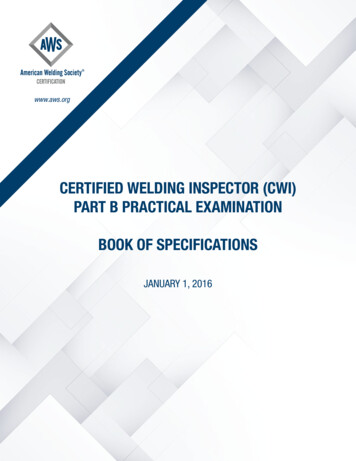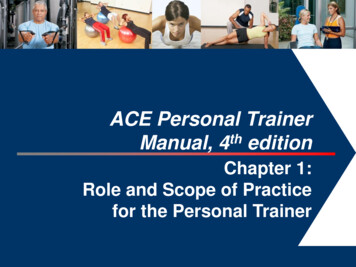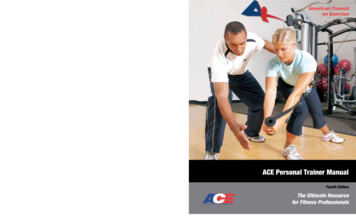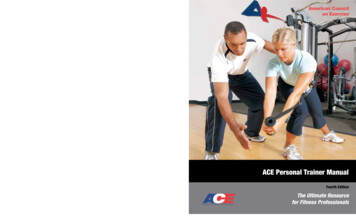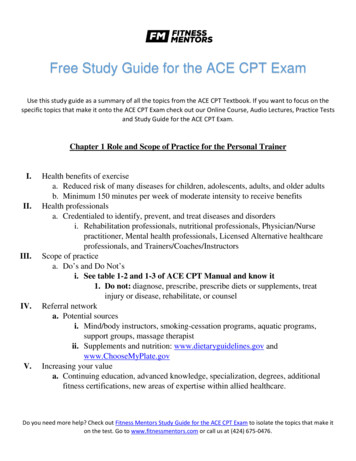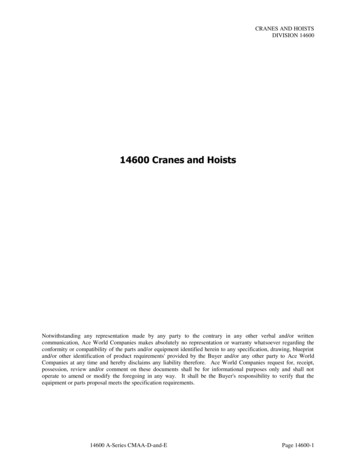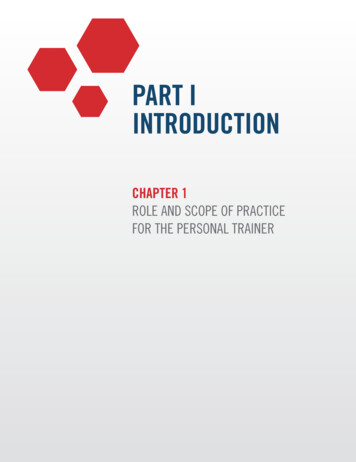
Transcription
PART IINTRODUCTIONCHAPTER 1ROLE AND SCOPE OF PRACTICEFOR THE PERSONAL TRAINER
1CHAPTERROLE AND SCOPE OF PRACTICE FOR THEPERSONAL TRAINERTODD GALATIIN THIS CHAPTER:The Allied HealthcareContinuumThe ACE Personal TrainerCertificationDefining “Scope of Practice”Scope of Practice for ACECertified Personal TrainersKnowledge, Skills, andAbilities of the ACE CertifiedPersonal TrainerProfessional Responsibilitiesand EthicsAccreditation of AlliedHealthcare CredentialsThrough the NCCARecognition From the Fitnessand Health IndustryRecognition From theEducation CommunityRecognition From theDepartment of LaborCareer DevelopmentContinuing EducationDegreesAdditional FitnessCertificationsNew Areas of Expertise WithinAllied HealthcareSummaryTHE BENEFITS RESULTING FROM REGULAR PHYSICAL ACTIVITY AREwell documented (Table 1-1). After a comprehensive review of the research linkingphysical activity to health, the U.S. Department of Health & Human Services(2008) released the 2008 Physical Activity Guidelines for Americans, the firstcomprehensive guidelines on physical activity to be issued by the U.S. government.These guidelines list the following major research findings regarding physicalactivity and its associated health benefits: Regular physical activity reduces the risk of many adverse health outcomes. Some physical activity is better than none. For most health outcomes, additional benefits occur as the amount of physicalactivity increases through higher intensity, greater frequency, and/or longerduration. Most health benefits occur with at least 150 minutes a week of moderateintensity physical activity, such as brisk walking. Additional benefits occur withmore physical activity.TODD GALATI, M.A., is the director of credentialing for the American Council on Exercise. He holds a bachelor’sdegree in athletic training, a master’s degree in kinesiology, and four ACE certifications (Advanced Health &Fitness Specialist, Personal Trainer, Health Coach, and Group Fitness Instructor). Prior to joining ACE, Galatiwas a program director with the University of California, San Diego School of Medicine, where he researched theeffectiveness of youth fitness programs in reducing risk for cardiovascular disease, obesity, and type 2 diabetes.Galati’s experience includes teaching biomechanics, applied kinesiology, and anatomy classes at Cal State SanMarcos and San Diego State University, working as a research physiologist with the U.S. Navy, personal training inmedical fitness facilities, and coaching endurance athletes.
ACE PERSONAL TRAINER MANUAL ROLE AND SCOPE OF PRACTICE FOR THE PERSONAL TRAINER CHAPTER 1 Both aerobic (endurance) and muscle-strengthening (resistance) physical activity arebeneficial. Health benefits occur for children and adolescents, young and middle-aged adults,older adults, and those in every studied racial and ethnic group. The health benefits of physical activity occur for people with disabilities. The benefits of physical activity far outweigh the possibility of adverse outcomes.Table 1-1Health Benefits Associated With Regular Physical ActivityChildren and AdolescentsStrong evidence Improved cardiorespiratory and muscular fitness Improved bone health Improved cardiovascular and metabolic health biomarkers Favorable body compositionModerate evidence Reduced symptoms ofdepressionAdults and Older AdultsStrong evidence Lower risk of early death Lower risk of coronary heart disease Lower risk of stroke Lower risk of high blood pressure Lower risk of adverse blood lipid profile Lower risk of type 2 diabetes Lower risk of metabolic syndrome Lower risk of colon cancer Lower risk of breast cancer Prevention of weight gain Weight loss, particularly when combined withreduced calorie intake Improved cardiorespiratory and muscular fitness Prevention of falls Reduced symptoms of depression Better cognitive function (for older adults)Moderate to strong evidence Better functional health(for older adults) Reduced abdominal obesityModerate evidence Lower risk of hip fracture Lower risk of lung cancer Lower risk of endometrialcancer Weight maintenance afterweight loss Increased bone density Improved sleep qualityU.S. Department of Health & Human Services (2008). 2008 Physical Activity Guidelines for Americans: Be Active, Healthy and ote: The Advisory Committee rated the evidence of health benefits of physical activity as strong, moderate, or weak. To do so, theCommittee considered the type, number, and quality of studies available, as well as consistency of findings across studies thataddressed each outcome. The Committee also considered evidence for causality and dose response in assigning the strength-ofevidence rating.3
4THE NEED FOR PERSONALTRAINERS TO HELPCOMBAT THE RISINGOBESITY EPIDEMICHAS LED TO APOSITIVE OUTLOOK FORPERSONAL TRAININGAS A PROFESSIONCHAPTER 1 ROLE AND SCOPE OF PRACTICE FOR THE PERSONAL TRAINER ACE PERSONAL TRAINER MANUALThese findings reinforce what fitness professionals have known for years: The humanbody was meant to move and, when it does so with regularity, it responds to the stressof physical movement with improved fitness and health. Guidelines with similar goalsand recommendations have been published in the past by the American College ofSports Medicine (ACSM) and American Heart Association (AHA) (Haskell et al., 2007),U.S. Department of Agriculture (USDA) (2010), International Association for the Studyof Obesity (Saris et al., 2003), Institute of Medicine (2002), and the U.S. Departmentof Health & Human Services (1996). The 2008 guidelines from the U.S. Departmentof Health & Human Services mark the the first time the U.S. government had enoughavailable research to make the claim that “all Americans should engage in regular physicalactivity to improve overall health and to reduce the risk of many health problems.”Even with well-established guidelines for physical activity, the majority ofhealthcare professionals have little or no formal education or practical experiencein designing and leading exercise programs. Physicians often give patientsrecommendations to exercise, but they generally do not provide specific instructionsfor how to exercise. ACE Certified Personal Trainers, therefore, play a vital rolein allied healthcare by providing services that help clients participate in effectiveexercise programs that result in positive health and fitness improvements.In the past, personal trainers have primarily worked with fitness enthusiasts intraditional fitness facilities. This role is changing due to the increasing number ofadults and children who are overweight or obese and have related health issues.Personal trainers must now be prepared to work with clients ranging in age fromyouth to older adults, and ranging in health and fitness status from sedentary toathletic. The need for personal trainers to help combat the rising obesity epidemichas led to a positive outlook for personal training as a profession.THE ALLIED HEALTHCARE CONTINUUMTHE ALLIED HEALTHCARE CONTINUUM IS COMPOSED OF HEALTH PROFESSIONALSwho are credentialed through certifications, registrations, and/or licensure andprovide services to identify, prevent, and treat diseases and disorders. Physiciansare at the top of the healthcare pyramid, evaluating patients to diagnose ailmentsand implement treatment plans that can include medication, surgery, rehabilitation,or other actions. Physicians are assisted in their efforts by nurses, physician’sassistants, and a number of other credentialed technicians. When ailments ortreatment plans fall outside their areas of expertise, physicians refer patients tospecialists for specific medical evaluations, physical or occupational therapy,psychological counseling, dietary planning, and/or exercise programming.EXPAND YOUR KNOWLEDGEUNDERSTANDING THE EDUCATIONAL REQUIREMENTS AND SCOPEOF PRACTICE FOR EACH POTENTIAL TEAM MEMBERAcupuncturist L.Ac. (licensed acupuncturist): A license granted by individual state entities, typically tohave confirmed national-level certification; able to perform acupuncture and may havecomplementary medical privileges (e.g., traditional Chinese medicine), and/or lab-orderingprivileges depending upon the state licensing laws
ACE PERSONAL TRAINER MANUAL ROLE AND SCOPE OF PRACTICE FOR THE PERSONAL TRAINER CHAPTER 1Chiropractor D.C. (doctor of chiropractic): Post-baccalaureate degree program, typically four years in length; a variety of differentchiropractic philosophies and practices exist; do not have prescription-writing or surgical privileges; however, dependingupon the state, may prescribe and dispense nutritional and herbal supplementsDietitians RD (registered dietitian): A baccalaureate-level degree with clinical practicum and national certification testing; in moststates, licensure is required to practice as an RDNaturopathic Physicians N.D. (naturopathic doctor): A four-year, graduate-level naturopathic medical school with all of the same basicsciences as a medical doctor (M.D.), but also studies holistic and nontoxic approaches to therapy with a strongemphasis on disease prevention and optimizing wellness; in addition, the naturopathic physician is required tocomplete four years of training in clinical nutrition, acupuncture, homeopathic medicine, botanical medicine,psychology, and counseling; licensure is by a state or jurisdiction as a primary care general practice physician;scope of practice varies by state lawNurses L.P.N. (licensed practical nurse): Typically an associate-level degree with clinical practicum R.N. (registered nurse), B.S.N. (bachelor of science in nursing): A baccalaureate-level degree with clinical practicumand state license/testing M.S.N.: Master of science in nursing A.R.N.P. (advanced registered nurse practitioner): Graduate-level degree, typically requiring several years of practicalclinical experience; able to prescribe some medications and practice somewhat independently Ph.D.: Doctorate in nursing studies; typically a title used in an academic settingPhysicians M.D. (doctor of medicine): Typically four years of post-baccalaureate medical school, at least three years of postgraduatetraining upon completion of the degree; able to prescribe medications and therapies; may have admitting privileges athospitals D.O. (doctor of osteopathy): same academic and clinical training as M.D.s, but also have instruction and practicum inosteopathic manipulationBehavioral Medicine Practitioners Counselor: Baccalaureate- or masters-level degree; some may have social work or other backgrounds with clinicalpracticum in psychological counseling D.Psy. (doctor of psychology): Doctorate level degree in psychologyPhysical Therapists P.T.A. (physical therapy aide/assistant): Aides are frequently trained on the job, while assistants have an associatelevel degree; in some states, the latter is required to have licensure in order to practice P.T. (physical therapist): A baccalaureate- or masters-level degree in a physical therapy course of study D.P.T. (doctor of physical therapy): A doctorate-level degree with a dissertation defense in physical therapyOccupational Therapists C.O.T.A. (certified occupational therapy aide/assistant): Aides are frequently trained on the job, while assistants have anassociate-level degree; in some states, the latter is required to have licensure in order to practice O.T. (occupational therapist): Baccalaureate- or masters-level degree in an occupational therapy courseof study Dr.O.T. (doctor of occupational therapy): A doctorate-level degree with a dissertation defense in occupational therapyAthletic Trainers A.T.C. (athletic trainer certified): A baccalaureate-level degree with national certification testing; typically state-regulated.Responsibilities include injury prevention, emergency care, and therapeutic intervention; working with the team physician;and rehabilitation of injured players after athletic injury or post-surgery5
6CHAPTER 1 ROLE AND SCOPE OF PRACTICE FOR THE PERSONAL TRAINER ACE PERSONAL TRAINER MANUALEXPAND YOUR KNOWLEDGETHE FUTURE OF PERSONAL TRAININGThe U.S. Department of Labor (DOL), Bureau of LaborStatistics (2014), refers to the professionals in the fitness industry as Fitness Workers, with Personal Trainersclassified as the primary profession within the industry. The DOL defines the nature of the job of personaltrainers as “work with a single client or a small group. They may train in a gym or in the clients’ homes.Personal fitness trainers assess the clients’ level of physical fitness and help them set and reach their fitnessgoals. Trainers also demonstrate various exercises and help clients improve their exercise techniques. Theymay keep records of their clients’ exercise sessions to monitor clients’ progress toward physical fitness. Theymay also advise their clients on how to modify their lifestyles outside of the gym to improve their fitness.”Expected Growth in Personal-training JobsAccording to the DOL, employment of fitness workers is projected to increase by 13% between 2012 and2022. This expected increase is about as fast as the average for all occupations, and is attributed to anumber of factors, including the following: Increasing numbers of baby boomers who want to stay healthy, physically fit, and independent Increases in businesses opening onsite fitness facilities and offering incentives for employees tojoin gyms Growing concerns about childhood obesity Increasing club memberships among young adults concerned about physical fitness An aging population seeking relief from arthritis and other ailments through individualized exercise,yoga, and Pilates A need to replace workers who leave fitness occupations each yearPersonal-trainer QualificationsSee “Recognition From the Department of Labor” on page 20 for the DOL’s statement regarding theimportance of obtaining a quality personal-training certification.Ph
ace personal trainer manual oe and scope of pactice fo the pesona taine chapter 1 Chiropractor D.C. (doctor of chiropractic): Post-baccalaureate degree program, typically four years in
